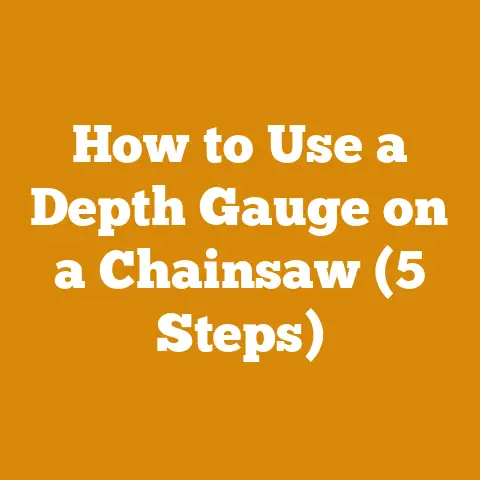Why Does My Husqvarna Chainsaw Leak Bar Oil (3 Causes)
I remember the first time I noticed bar oil leaking from my Husqvarna chainsaw. It was a crisp autumn morning, and I was gearing up for a weekend of cutting firewood with my family. The last thing I wanted was a slippery mess in the back of my truck. If you’ve found yourself in a similar situation, you’re probably wondering, “Why does this happen?” Let’s chat about it.
Why Does My Husqvarna Chainsaw Leak Bar Oil?
Chainsaws are incredible tools that make jobs easier, but they require care and understanding.
Common Causes
1. Overfilled Oil Reservoir
One day, I was in a rush to finish up for the weekend, thinking ahead to the family barbecue we had planned. In my haste, I overfilled the chainsaw’s oil reservoir. It seemed harmless at the time, but when the oil heats up, it expands, and if there’s too much, it’ll find its way out.
Here’s why overfilling can lead to leaks:
- Expansion: As temperatures rise inside the engine during use, the oil expands. With no room to expand, it pushes out through any available gap.
- Pressure Build-Up: The excess oil creates pressure that can compromise seals and other components.
Preventive Tips:
- Measure Carefully: Always fill the reservoir slowly and check levels frequently.
- Use a Funnel: This minimizes spills and helps control the amount of oil you add.
2. Damaged or Worn Oil Seals
One summer, after years of loyal service from my chainsaw, I noticed a persistent leak. Upon inspection, a small crack in an oil seal had developed into a more significant problem. These seals are crucial for keeping the oil contained.
Factors contributing to seal damage include:
- Age and Wear: Over time, rubber and plastic components degrade due to heat and chemical exposure.
- Physical Damage: Incorrect handling or storage can cause nicks or abrasions on seals.
Replacement Steps:
- Identify Problem Areas: Check around the oil reservoir and bar for any signs of leakage.
- Remove Old Seals: Use a screwdriver to carefully pry out damaged seals.
- Install New Seals: Ensure they fit snugly to prevent future leaks.
- Test for Leaks: Refill with oil and monitor for any signs of leakage after a test run.
3. Clogged Oil Passages
Imagine a blocked artery in your body; that’s what happens when debris clogs the oil passages in your chainsaw. This blockage can build up pressure and cause leaks.
Common causes of clogged passages:
- Sawdust and Debris: During operation, sawdust can accumulate in and around oil passages.
- Improper Cleaning: Neglecting regular cleaning routines allows buildup to develop over time.
Cleaning Procedure:
- Disassemble Protective Covers: Use screwdrivers to access internal components.
- Wipe Away Debris: Use clean rags or a soft brush to remove dirt and sawdust.
- Inspect Channels: Ensure the passages are clear and unobstructed.
Equipment Requirements
Before diving deeper into maintenance, gather these essential tools and materials:
- Safety Gloves: Protect your hands from sharp parts and chemicals.
- Protective Eyewear: Keep your eyes safe from debris.
- Screwdrivers (Phillips and Flathead): For disassembly and assembly tasks.
- Clean Rags: To wipe away oil and debris.
- Replacement Seals: In case you need to replace worn or damaged ones.
- Oil Catch Container: To collect any spilled or drained oil.
Prerequisite Knowledge
Understanding your chainsaw’s components is vital. Familiarize yourself with the user manual, focusing on parts like:
- Oil Reservoir: Where the bar oil is stored.
- Bar and Chain: The cutting components that require lubrication.
- Seals and Gaskets: Prevent oil from leaking out.
Step-by-Step Troubleshooting
Step 1: Check the Oil Level
Every time I use my chainsaw, I start by checking the oil level. It’s a simple step that can prevent many issues:
- Turn Off Chainsaw: Ensure it’s off and cool before inspection.
- Remove Oil Cap: Carefully unscrew to avoid spills.
- Check Level: Use a dipstick if available or visually inspect.
- Adjust Level: If too high, drain some into an oil catch container.
Step 2: Inspect Oil Seals
Oil seals are like the unsung heroes of your chainsaw—often overlooked but vital:
- Put on Safety Gloves: Protect your hands during inspection.
- Examine Seals Around Reservoir: Look for cracks or signs of wear.
- Replace as Needed: Swap out damaged seals with new ones.
Step 3: Clean Oil Passages
It’s amazing how much difference a good cleaning can make:
- Access Internal Components: Unscrew protective covers to get to passages.
- Use Clean Rag or Brush: Wipe away accumulated debris carefully.
- Ensure Passages Are Clear: Check for blockages that could cause pressure build-up.
Tips & Warnings
Tip: Regular maintenance prevents leaks and prolongs your chainsaw’s life.
Warning: Always ensure the chainsaw is off and cool before attempting any inspection or repair.
Addressing Common Concerns
Why does my chainsaw leak only when not in use?
It’s frustrating when you notice a leak after storing your chainsaw. This often happens due to:
- Settling Oil: When stationary, oil may settle and find weak spots in seals.
- Temperature Changes: Fluctuations can cause expansion and contraction in seals.
Can I use any bar oil for my Husqvarna?
I once tried using a generic bar oil during an emergency, thinking any oil would do. Big mistake! Always stick with manufacturer-recommended oils:
- Compatibility: Ensures optimal performance and longevity.
- Viscosity Match: Proper thickness for temperature conditions.
Best Practices for Maintenance
Regular maintenance is like giving your chainsaw a spa day—it appreciates it!
Routine Checks:
- Monthly Inspections: Look for wear on seals and other components.
- After Each Use: Wipe down surfaces and check oil passages for debris.
Storage Tips:
Here are some reminders:
- Regular maintenance is key to preventing leaks.
- If you’re ever unsure about handling repairs, consult a professional. A small leak now can lead to bigger issues down the road if not addressed promptly.
FAQ Section
Q: How often should I check my chainsaw’s oil level?
A: Check before each use to prevent overfilling or running dry.
Q: Can I fix a leaking seal myself?
A: Yes, with basic tools and replacement seals. But if you’re uncomfortable, seek professional help.
Q: What if my chainsaw still leaks after trying all this?
A: Persistent leaks may indicate deeper mechanical issues; it might be time for a professional inspection.
In your journey with your Husqvarna chainsaw, remember that a little care goes a long way. From one chainsaw enthusiast to another, happy cutting!






